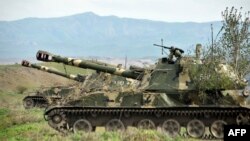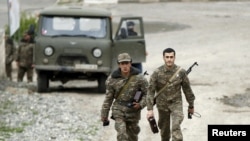Nagorno-Karabakh’s Armenian-backed leadership has embarked on the construction of new defense fortifications along “the line of contact” around the territory following this month’s heavy fighting between Armenian and Azerbaijani forces deployed there.
“Military engineering works on the frontlines are in progress right now,” Ara Harutiunian, the Karabakh prime minister, said on Wednesday evening at a meeting with senior government and military officials in Stepanakert and the top executives of local construction firms.
“This must remain a top priority for us for some time because, as have we have once again seen, only strong borders and the bravery of Armenian soldiers can guarantee peace for our children,” he told them, according to his press office.
Harutiunian was also quoted as saying that the government of the unrecognized Nagorno-Karabakh Republic (NKR) will promptly provide construction firms with “appropriate resources” so that they “organize the works in a timely and efficient manner.” He told government and military bodies to “closely cooperate with the companies.”
An RFE/RL correspondent witnessed the strengthening of Armenian fortifications earlier this week when he visited the northern Karabakh village of Talish, one of the epicenters of bloody hostilities that broke out on April 2.
The Azerbaijani army launched an offensive at northern and southern sections of “the line of contact.” At least 170 soldiers from both sides died in the ensuing fierce clashes that were largely stopped by a Russian-brokered ceasefire on April 5. The flare-up of violence, the worst since 1994, has been unofficially dubbed a “four-day war.”
Davit Babayan, the spokesman for Bako Sahakian, the NKR president, said on Thursday that the Karabakh Armenian leadership is now making contingency plans against another possible Azerbaijani assault. “This situation requires us to revise some components of our defense system,” Babayan told RFE/RL’s Armenian service (Azatutyun.am).
“If the enemy now uses heavy artillery and other long-range weapons, it is only natural that we reinforce our fortifications and make corresponding changes in our tactic and strategy,” he said.
Babayan said that as part of the same effort the Karabakh Armenians will also receive more weapons for their Defense Army closely integrated with Armenia’s armed forces. He said Armenian President Serzh Sarkisian discussed the matter with Sahakian and the Defense Army commanders when he visited Karabakh this week.
No details of those discussions were made public. Sarkisian also toured Karabakh army bases located close to the frontlines and handed medals to more than 30 Armenian soldiers during the three-day visit.





